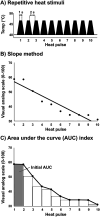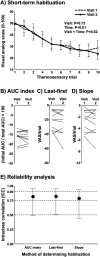Anti-nociceptive properties of cardiopulmonary baroreceptors in patients with chronic back pain
- PMID: 40786621
- PMCID: PMC12331587
- DOI: 10.3389/fpain.2025.1593939
Anti-nociceptive properties of cardiopulmonary baroreceptors in patients with chronic back pain
Abstract
Introduction: Reduced pain perception following a persistent noxious stimulus during a study session (short-term habituation) is believed to be partially mediated by descending inhibitory mechanisms, although these mechanisms have not been fully elucidated. We examined the hypothesis that cardiopulmonary baroreceptor would significantly increase short-term habituation in chronic back pain (CBP) patients.
Methods: A short-term habituation protocol was utilized that involved 1-sec pulses (×10) at 105% heat pain threshold on the anterior forearm at 0.5 Hz. Cardiopulmonary baroreceptor unloading was performed via lower body negative pressure (LBNP) that reduces central venous pressure to elicit a reflex increase in sympathetic nerve activity.
Results: Short-term habituation was observed in young, healthy participants (n = 11), as indicated by a reduction in subjective pain ratings across the 10 repetitive heat pulses (-42% ± 29, P < 0.01, n = 11). Short-term habituation was also observed in CBP patients (-32% ± 30, P < 0.01, n = 12). Cardiopulmonary baroreceptor unloading via LBNP significantly reduced pain ratings across the 10 repetitive heat pulses in CBP patients compared with supine control (patient positioned in LBNP chamber but without a reduction in pressure) and upright sitting (chair), as indicated by a more negative area under the curve index (LBNP: -16.3 ± 4.1; Control: -14.4 ± 2.6; Upright sitting: -15.1 ± 4.1, P = 0.02). However, LBNP-mediated reductions in pain ratings were selective to CBP patients with more severe symptoms, i.e., neuropathic pain (LBNP: -14.7 ± 2.1; Control: -12.8 ± 1.4; Upright sitting: -12.1 ± 1.2, P = 0.04), whereas no effect of LBNP was observed in young, healthy participants (P = 0.83). In support, CBP patients with neuropathic pain exhibited significantly elevated mechanical pressure pain threshold during LBNP (P = 0.04).
Conclusions: Together, these findings demonstrate an association between cardiopulmonary baroreceptor unloading and a reduction in pain perception during repetitive noxious stimuli in CBP patients, particularly among CBP patients with greater pain severity.
Keywords: baroreflex; cardiopulmonary; chronic pain; descending inhibition; sympathetic nerve activity (SNA).
© 2025 Iwakuma, Liu, Clonch, Gangwish, Lam and Holwerda.
Conflict of interest statement
The authors declare that the research was conducted in the absence of any commercial or financial relationships that could be construed as a potential conflict of interest.
Figures






Similar articles
-
Cardiopulmonary baroreceptors modify pain intensity in patients with chronic back pain.Res Sq [Preprint]. 2023 Jul 17:rs.3.rs-3154622. doi: 10.21203/rs.3.rs-3154622/v1. Res Sq. 2023. PMID: 37502833 Free PMC article. Preprint.
-
The Black Book of Psychotropic Dosing and Monitoring.Psychopharmacol Bull. 2024 Jul 8;54(3):8-59. Psychopharmacol Bull. 2024. PMID: 38993656 Free PMC article. Review.
-
Intravenous magnesium sulphate and sotalol for prevention of atrial fibrillation after coronary artery bypass surgery: a systematic review and economic evaluation.Health Technol Assess. 2008 Jun;12(28):iii-iv, ix-95. doi: 10.3310/hta12280. Health Technol Assess. 2008. PMID: 18547499
-
Systemic pharmacological treatments for chronic plaque psoriasis: a network meta-analysis.Cochrane Database Syst Rev. 2017 Dec 22;12(12):CD011535. doi: 10.1002/14651858.CD011535.pub2. Cochrane Database Syst Rev. 2017. Update in: Cochrane Database Syst Rev. 2020 Jan 9;1:CD011535. doi: 10.1002/14651858.CD011535.pub3. PMID: 29271481 Free PMC article. Updated.
-
Systemic pharmacological treatments for chronic plaque psoriasis: a network meta-analysis.Cochrane Database Syst Rev. 2021 Apr 19;4(4):CD011535. doi: 10.1002/14651858.CD011535.pub4. Cochrane Database Syst Rev. 2021. Update in: Cochrane Database Syst Rev. 2022 May 23;5:CD011535. doi: 10.1002/14651858.CD011535.pub5. PMID: 33871055 Free PMC article. Updated.
References
-
- Vossen CJ, Vossen HGM, Joosten EA, van Os J, Lousberg R. Does habituation differ in chronic low back pain subjects compared to pain-free controls? A cross-sectional pain rating ERP study reanalyzed with the ERFIA multilevel method. Medicine (Baltimore). (2015) 94:e865. 10.1097/MD.0000000000000865 - DOI - PMC - PubMed
LinkOut - more resources
Full Text Sources
Research Materials

